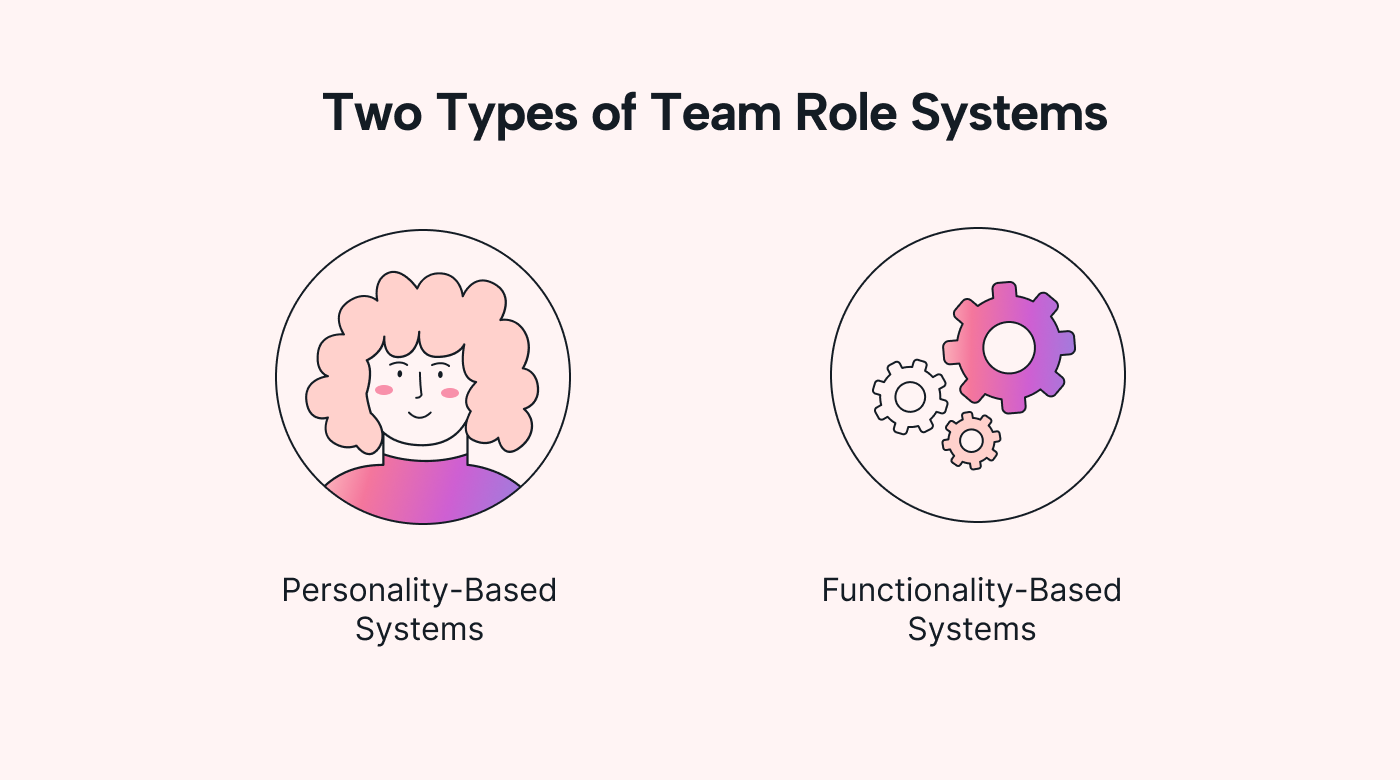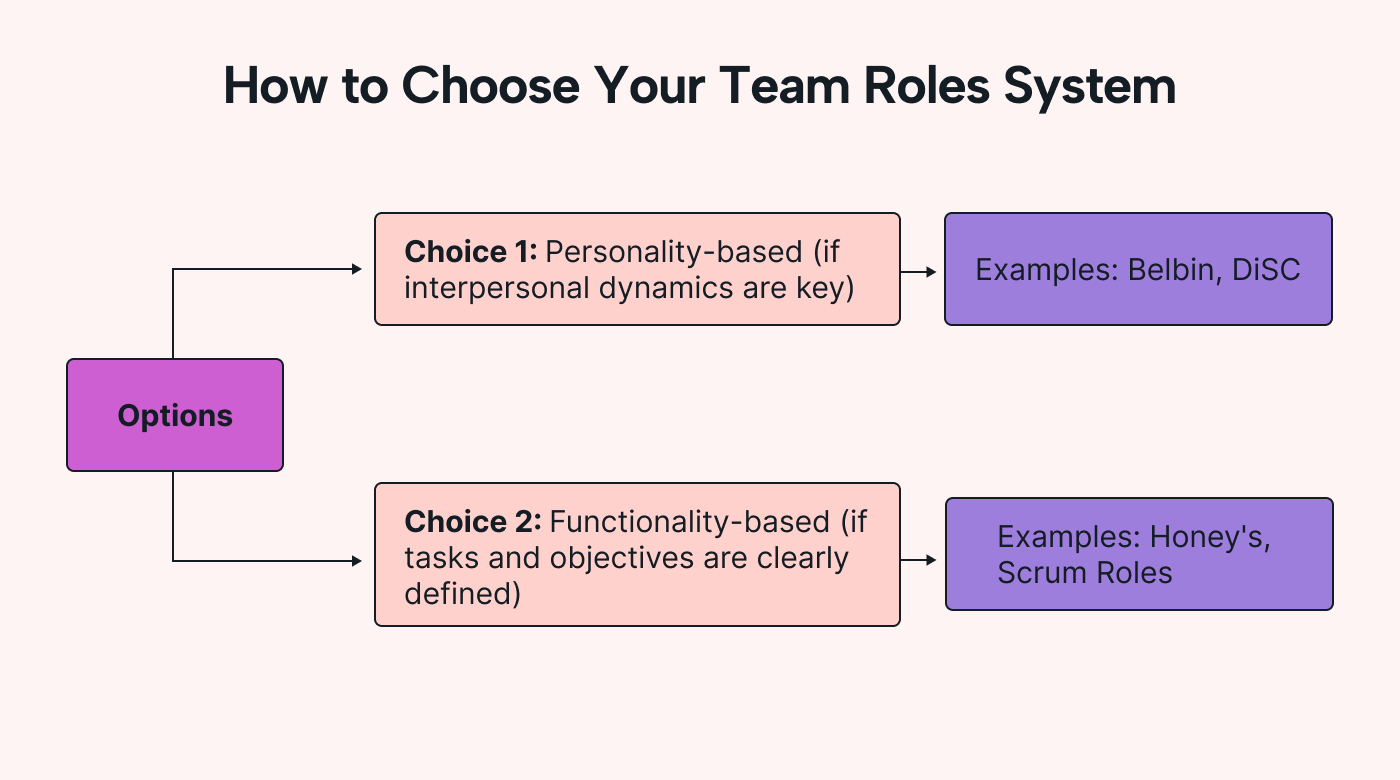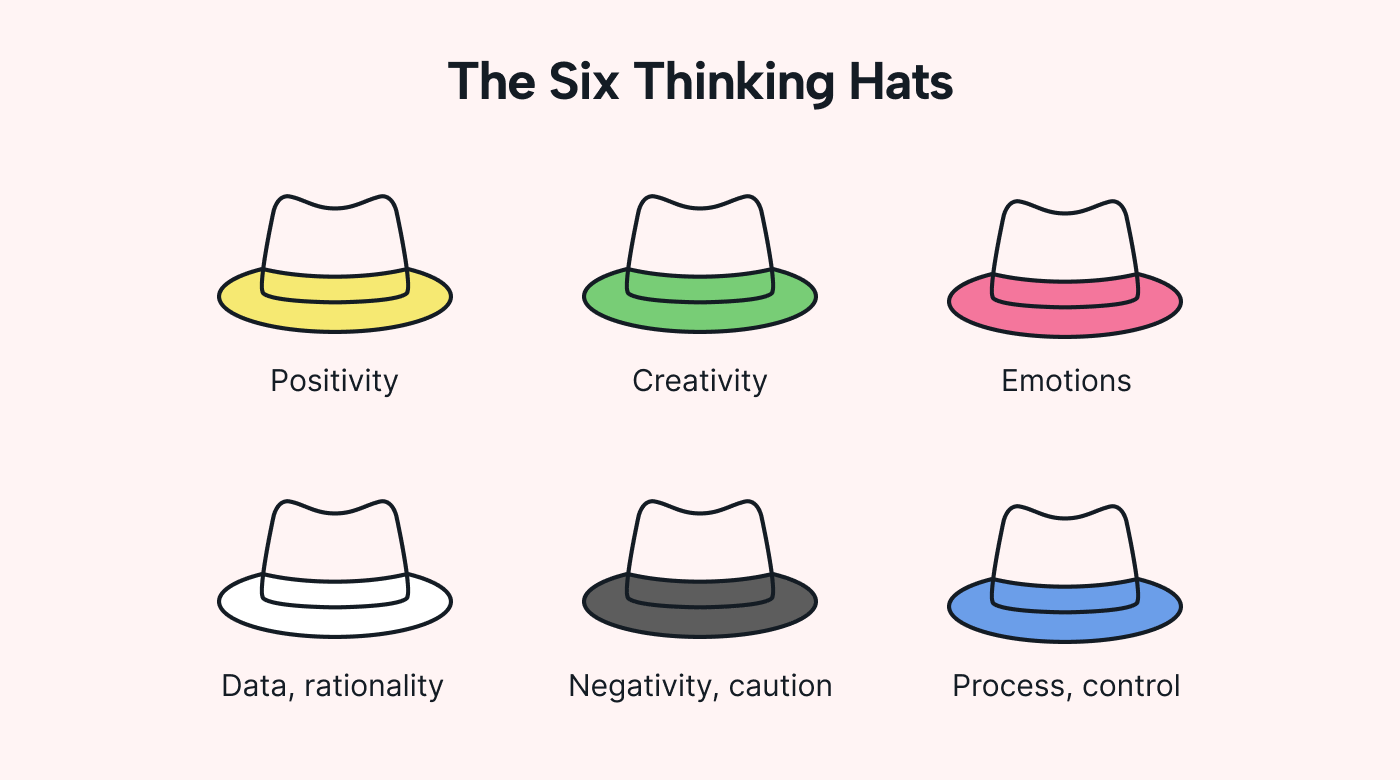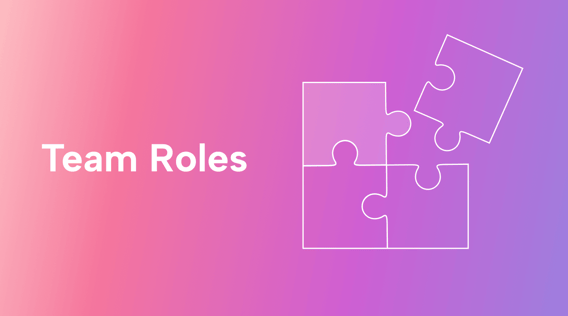The days of teams consisting of a team leader and a group of dutiful employees have long gone the way of the dodo.
The science of team dynamics shows that there’s a broad spectrum of team roles and that each person naturally gravitates to a specific one.
A variety of systems have been developed that assign different roles to people to better engage them and help them function at their best. But with so many systems out there, how do leaders know which ones are most suitable for their teams?
That’s where this guide comes in.
We’ll walk you through the choices and help you select the most suitable roles for your team.
Two types of systems for team roles
First, it’s important to understand the two main ways that team roles are classified. Here’s a brief overview:
 |
Personality-based team role systems
Personality-based team role systems focus on personality types and preferred work styles. They recognize that people in a team environment have different personality strengths and weaknesses.
Team leaders and members learn to recognize these roles in themselves and others and together create a balanced team environment where every role is understood and valued.
Here are three examples of personality-based systems:
The 9 Belbin Team Roles system
The Belbin Team Roles system developed by Dr. Meredith Belbin identifies nine distinct roles that individuals tend to adopt within teams. These roles are as follows: Plant (idea generator), Resource Investigator, Coordinator, Shaper (driver), Monitor/Evaluator, Teamworker, Specialist, Implementer, and Completer/Finisher.
The DiSC Profile system
The DiSC Profile system is a personality assessment tool that categorizes individuals into one of four primary behavior types that are easily observed in a team environment: Dominance (D), Influence (I), Steadiness (S), and Conscientiousness (C).
The Myers-Briggs system
The Myers-Briggs Type Indicator (MBTI) is a widely used psychological tool that classifies individuals into one of 16 personality types based on four dichotomies: Extraversion/ Introversion, Sensing/Intuition, Thinking/Feeling, and Judging/Perceiving.
Though often used in personal development, teams also employ this system to improve communication and collaboration.
 |
Because these different sets of roles are personality-based, they are mostly unchanging. For example, if you’re a Dominant person (a driver), that’s likely how you’ll be seen for most of your career — and even in your personal life. And if you’re a Finisher, you’ll pretty much always be valued for being a Finisher.
Functionality-based team role systems
These systems take a functional approach to team roles instead of a personality-based one. Classic functionality-based team roles include the facilitator, the note-taker, and the time-keeper — but they’ve evolved beyond this basic role division.
These classifications recognize that teams function best if the members take on specific, detailed roles that help the team get the most out of their meetings and projects. Because these roles are function-oriented, they can be assigned more easily to any team member than roles based on psychological traits.
However, there’s some overlap with personality-based roles in the sense that team leaders may recognize which of these roles best fit certain team members, given their personality types.
In the same vein, when the team leader invites the team members to volunteer for certain roles, the latter tend to naturally gravitate toward the roles that are most compatible and comfortable to them due to their personality types.
Here are three examples of functionality-based systems:
Honey’s Five Team roles
Developed by Peter Honey, this model categorizes team members into five essential roles that contribute to successful team performance and a balanced approach to project execution.
These roles are as follows: the Creator, who generates ideas; the Executor, who turns ideas into actionable plans; the Analyzer, who evaluates and refines ideas; the Leader, who provides direction; and the Finisher, who ensures tasks are completed to the end.
The RACI Matrix
The RACI Matrix is a responsibility assignment tool that clarifies roles in relation to tasks or decisions. RACI stands for Responsible (the person who does the work), Accountable (the person who’s ultimately answerable), Consulted (the person who gives their input), and Informed (the person who needs to stay updated).
Scrum roles
In the Scrum agile project management framework, there are three defined Scrum roles that are essential for effective product development. The Scrum Master ensures the team follows Scrum practices and addresses any obstacles. The Product Owner manages the product backlog, sets priorities, and liaises with stakeholders. The Development Team consists of professionals who do the actual designing, building, and testing of the product.
 |
Now that we’ve covered the differences between personality-based and functionality-based team role classification systems, let’s move on to how to choose the system that will most benefit your team and the projects the team is responsible for.
How to select the best team role system for your team: A step-by-step guide
Team role assignments often happen a bit haphazardly, which can generate team indifference, pushback, or even resistance to playing assigned roles.
Follow the eight steps below to make an informed, practical, and effective team role system for your team.
In steps one through four, check off the boxes that best fit your situation.
Step 1: Be clear about your team’s objectives
Begin by clearly defining the team’s nature and objectives.
☐ Personality-based: The team is focused on innovation or a high degree of customer interaction, where understanding interpersonal team dynamics is very important.
☐ Functionality-based: The team is project-oriented or focused mostly on getting tasks done.
Reflect on the scope of the projects or tasks the team will be involved in.
☐ Personality-based: The team’s projects are quite broad and routine, but the quality will suffer if team members don’t interact well or effectively.
☐ Functionality-based: Highly defined, detailed projects often benefit from clearly defined functional roles.
Consider whether the team is a long-term entity, a short-term project team, or flexible in its lifespan.
☐ Personality-based: Long-term teams might benefit from a deeper understanding and development of interpersonal dynamics.
☐ Functionality-based: Short-term teams or project-specific teams often benefit from functionality-based systems for quick role allocations.
Step 2: Assess the type of work the team usually performs
Is the work complex and multifaceted, or is it straightforward?
☐ Personality-based: Most suitable for complex tasks in which collaboration and communication are key.
☐ Functionality-based: Best for straightforward, task-oriented projects.
Does the work require specialized knowledge or skills?
☐ Personality-based: The team knows its work well but has a need for human interaction to keep things interesting and stay motivated.
☐ Functionality-based: Specialized tasks often have specific functional roles that need filling.
How dependent are the team members on each other’s work?
☐ Personality-based: High interdependency often requires strong communication and collaboration skills, so getting along is critical.
☐ Functionality-based: A high degree of individual work benefits more from functional team roles to keep things moving along.
 |
Step 3: Evaluate the team dynamics of your particular team
Consider the size of your team.
☐ Personality-based: Smaller teams with more intense interactions may need a stronger focus on interpersonal relationships.
☐ Functionality-based: Larger teams may find it easier to allocate specific functional roles.
Evaluate your team’s diversity in terms of their skills, cultures, and backgrounds.
☐ Personality-based: Diverse teams may benefit from personality-based systems to better manage their interpersonal dynamics.
☐ Functionality-based: Homogenous teams may function optimally when using functional team roles.
Are there any particularly difficult personalities or potential conflicts?
☐ Personality-based: If yes, then understanding personality types can help a lot with conflict resolution and building a more harmonious team.
☐ Functionality-based: If no, then the team will probably do well with functional, rotating roles.
Step 4: Consider the ease or difficulty of implementing a new system
Do you have the resources to implement a detailed personality test?
☐ Personality-based: Such tests often require considerable resources and time, so consider them an investment in the longer-term health and balance of your team.
☐ Functionality-based: These systems are easily explained and require minimal extra training.
Step 5: Choose the best type of team role system
Now that you’ve analyzed your team’s situation, you’re well-equipped to make a selection based on the preponderance of your checkmarks. To sum it up:
Personality-based systems: These are beneficial when team members have diverse skills but need to improve their collaboration and interpersonal relationships. They are ideal for teams where understanding interpersonal dynamics is key.
If you want to take a deep dive into team dynamics, consider working with the Belbin Team Roles or the Myers-Briggs Type Indicator. For a simpler approach, the DiSC system is a great place to start. Comparable systems include the Big Five Personality Test and True Colors.
Functionality-based systems: These focus on defining roles based on tasks and responsibilities. They are ideal for project-based teams where objectives are clearly defined and in situations where there’s an urgency to produce immediate results.
Good general systems include Honey’s Five Team Roles and the RACI Model. And for specialized roles in an agile setting, Scrum roles are useful.
 |
Step 6: Test the waters
Before rolling out the system, conduct a pilot test on a smaller scale to see how the team members take to the new system.
Collect feedback from the team to determine how well the system is working, and make any necessary adjustments based on that feedback.
Step 7: Implement and experiment
Train the team on how to use the chosen system. Regularly monitor how the team is adjusting. Be willing to make tweaks or even change the system entirely based on the outcomes.
Be flexible and experiment. Even if you settle on a personality-based approach, there may be times when these roles can be set aside for a functionality-based approach, such as when a quick review or project allocation is needed.
Step 8: Review and refine
Periodically evaluate how well your team is functioning, and ask for team input on how the system is impacting their work.
Never consider the system set in stone. Continuously look for opportunities to improve.
By following the eight steps above, team leaders can make a well-informed decision on which system will best suit their team’s unique requirements and bring about more effective and harmonious teamwork.
Getting stuck in team roles? Shake things up with the “Six Thinking Hats” technique
What if team roles just aren’t working well or are becoming too routine and boring? What if your team members start to object to always playing the same role?
Try the Six Hats method, which uses functional team roles without pinning them on specific people.
This system, developed by Edward de Bono, is a tool for group discussion and creative thinking. It uses six different-colored hats to represent six different modes of thinking.
 |
Having team members “put on” different hats, either individually or collectively, helps them approach problems from multiple angles. This helps ensure better decision-making and a more comprehensive understanding of the issue at hand.
Here’s a brief overview of the six roles:
White Hat: This hat represents facts, figures, and information. When wearing it, participants focus on the available data and assess what is known and not known.
Red Hat: This hat represents emotions, feelings, and intuition. When participants put it on, they express their gut feelings without any need for justification.
Black Hat: This hat represents critical judgment. It’s used to identify potential problems or obstacles. While wearing it, participants look for risks, downsides, and reasons why ideas may not work.
Yellow Hat: This hat represents optimism and positive judgment. Team members wearing it look for benefits and how things can be made to work by focusing on the positives.
Green Hat: This hat represents creativity and new ideas. When participants put it on, they think outside the box and explore alternative solutions and novel approaches without fear of being immediately criticized or shot down.
Blue Hat: This hat represents control and organization. While it’s often worn by the facilitator to manage the thinking process, team members can also wear it to step back and look at a situation from a higher-level perspective.
By switching hats during a discussion, team members are encouraged to look at the issue from different perspectives. This helps create a more rounded view of the problem and potential solutions.
The Six Thinking Hats theory is a fun, creative, and effective method to break your team out of the team roles box when you need to.
The right team role selection can make or break your team
Team roles help a group of people function optimally. Choose the best role system for your team based on your unique needs. This decision begins by understanding the differences between personality-based and functionality-based roles.
Consider using Motion’s AI-driven intelligent Project Manager to help you further optimize your team. It creates visual representations of each team member’s tasks and roles. Try Motion for free for 7 days.





